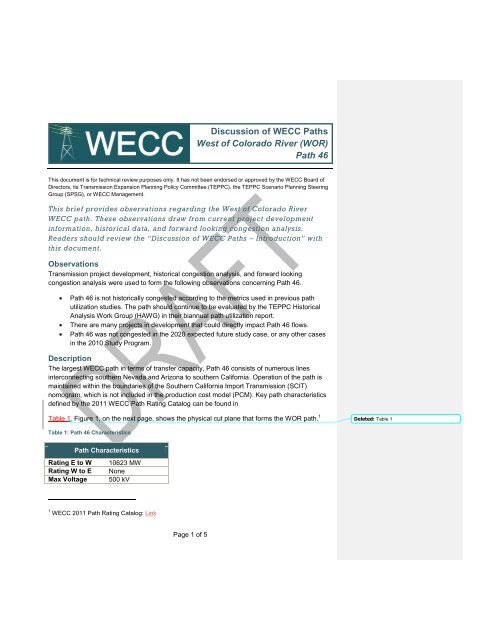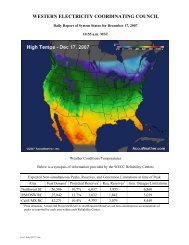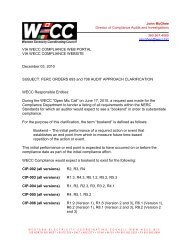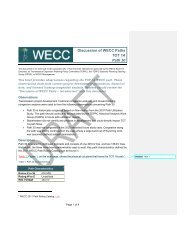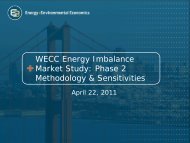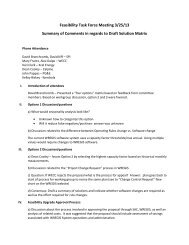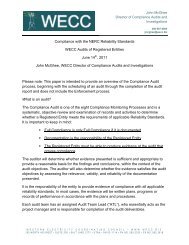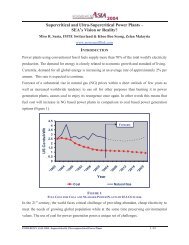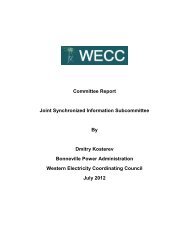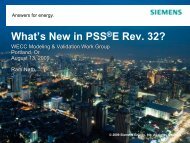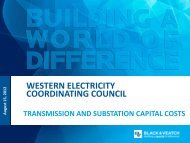Discussion of WECC Paths West of Colorado River (WOR) Path 46
Discussion of WECC Paths West of Colorado River (WOR) Path 46
Discussion of WECC Paths West of Colorado River (WOR) Path 46
- No tags were found...
Create successful ePaper yourself
Turn your PDF publications into a flip-book with our unique Google optimized e-Paper software.
<strong>Discussion</strong> <strong>of</strong> <strong>WECC</strong> <strong><strong>Path</strong>s</strong><strong>West</strong> <strong>of</strong> <strong>Colorado</strong> <strong>River</strong> (<strong>WOR</strong>)<strong>Path</strong> <strong>46</strong>This document is for technical review purposes only. It has not been endorsed or approved by the <strong>WECC</strong> Board <strong>of</strong>Directors, its Transmission Expansion Planning Policy Committee (TEPPC), the TEPPC Scenario Planning SteeringGroup (SPSG), or <strong>WECC</strong> Management.This brief provides observations regarding the <strong>West</strong> <strong>of</strong> <strong>Colorado</strong> <strong>River</strong><strong>WECC</strong> path. These observations draw from current project developmentinformation, historical data, and forward looking congestion analysis.Readers should review the “<strong>Discussion</strong> <strong>of</strong> <strong>WECC</strong> <strong><strong>Path</strong>s</strong> – Introduction” withthis document.ObservationsTransmission project development, historical congestion analysis, and forward lookingcongestion analysis were used to form the following observations concerning <strong>Path</strong> <strong>46</strong>.<strong>Path</strong> <strong>46</strong> is not historically congested according to the metrics used in previous pathutilization studies. The path should continue to be evaluated by the TEPPC HistoricalAnalysis Work Group (HAWG) in their biannual path utilization report.There are many projects in development that could directly impact <strong>Path</strong> <strong>46</strong> flows.<strong>Path</strong> <strong>46</strong> was not congested in the 2020 expected future study case, or any other casesin the 2010 Study Program.DescriptionThe largest <strong>WECC</strong> path in terms <strong>of</strong> transfer capacity, <strong>Path</strong> <strong>46</strong> consists <strong>of</strong> numerous linesinterconnecting southern Nevada and Arizona to southern California. Operation <strong>of</strong> the path ismaintained within the boundaries <strong>of</strong> the Southern California Import Transmission (SCIT)nomogram, which is not included in the production cost model (PCM). Key path characteristicsdefined by the 2011 <strong>WECC</strong> <strong>Path</strong> Rating Catalog can be found inTable 1. Figure 1, on the next page, shows the physical cut plane that forms the <strong>WOR</strong> path. 1Deleted: Table 1Table 1: <strong>Path</strong> <strong>46</strong> Characteristics<strong>Path</strong> CharacteristicsRating E to W 10623 MWRating W to E NoneMax Voltage 500 kV1 <strong>WECC</strong> 2011 <strong>Path</strong> Rating Catalog: LinkPage 1 <strong>of</strong> 5
<strong>Discussion</strong> <strong>of</strong> <strong>WECC</strong> <strong><strong>Path</strong>s</strong><strong>West</strong> <strong>of</strong> <strong>Colorado</strong> <strong>River</strong> - <strong>Path</strong> <strong>46</strong>Figure 1: <strong>Path</strong> <strong>46</strong> DefinitionHistorical Congestion<strong>Path</strong> <strong>46</strong> was analyzed in the 2009 and 2008 Transmission <strong>Path</strong> Utilization Studies and was nothistorically congested based on the metrics used in the analysis. In the 2008 Study <strong>Path</strong> <strong>46</strong>operated at U75 for only one percent <strong>of</strong> the year. The path never reached U90 and appeared tobe one <strong>of</strong> the least utilized paths in the <strong>West</strong>ern Interconnection in 2008. The 2009 Study alsoshowed relatively low utilization <strong>of</strong> <strong>Path</strong> <strong>46</strong>. It was calculated that there was 90 percentprobability that 3307 MW <strong>of</strong> unused capacity existed at any given time on <strong>Path</strong> <strong>46</strong>. That equatesto 31 percent <strong>of</strong> the path’s total transfer capability. Actual flow data for historic years can befound in the duration plot in Figure 2. Although informative, the plot does not necessarily reflectthe metrics that support, or exclude, the path as being historically congested.Deleted: anlaysisDeleted: 1%Deleted: %Deleted: %Page 2 <strong>of</strong> 5
Figure 2: <strong>Path</strong> <strong>46</strong> Actual Flow Duration Plot<strong>Discussion</strong> <strong>of</strong> <strong>WECC</strong> <strong><strong>Path</strong>s</strong><strong>West</strong> <strong>of</strong> <strong>Colorado</strong> <strong>River</strong> - <strong>Path</strong> <strong>46</strong>Project DevelopmentThe following projects were determined by stakeholders to be the most likely to have an impacton <strong>Path</strong> <strong>46</strong>.Blythe – Devers (SCG Foundational Project)Centennial <strong>West</strong> Clean Line (Studied in 2010 Study Program)Chinook (Studied in 2010 Study Program)Harcuvar Transmission ProjectHigh Plains Express (Studied in 2010 Study Program)Navajo Transmission Project (Studied in 2010 Study Program)Palo Verde – BlythePalo Verde – N. Gila #2 (SCG Foundational Project)Southline ProjectSunZia (Studied in 2010 Study Program)TCP (Harry Allen to Eldorado/Mead)Trans<strong>West</strong> Express (Studied in 2010 Study Program)Zephyr (Studied in 2010 Study Program)Page 3 <strong>of</strong> 5
Flow (MW)<strong>Discussion</strong> <strong>of</strong> <strong>WECC</strong> <strong><strong>Path</strong>s</strong><strong>West</strong> <strong>of</strong> <strong>Colorado</strong> <strong>River</strong> - <strong>Path</strong> <strong>46</strong>The projects identified as an SCG Foundational Project were assumed constructed in the 2020dataset.Future Congestion AnalysisThe forward looking congestion analysis draws upon study case results from production costmodel runs based on 2019 and 2020 datasets. This work was done as a part <strong>of</strong> the 2010 StudyProgram.Expected Future<strong>Path</strong> <strong>46</strong> was not heavily utilized or congested in the expected future case. The path neverexceeded U90 and operated at or above U75 for only 1.48 percent <strong>of</strong> the year. The duration plotin Figure 3 shows this light utilization. The chronological plot in the same figure shows theseasonality <strong>of</strong> the flows.Deleted: %Figure 3: <strong>Path</strong> <strong>46</strong> 2020 Duration Plot12000Duration Plot<strong>Path</strong> <strong>46</strong> in 2020 Reference Case100008000Positive = E to WNegative = W to E6000400020000-20001 1001 2001 3001 4001 5001 6001 7001 8001Hour <strong>of</strong> YearFlow (MW) Duration Flow (MW) Positive/Negative LimitAlternative Futures<strong>Path</strong> <strong>46</strong> did not pass the utilization screening in any <strong>of</strong> the 15 cases used to inform the 10-YearPlan. There was no combination <strong>of</strong> assumptions that caused the path to be highly utilized.Conditional CongestionCongestion along <strong>Path</strong> <strong>46</strong> is not contingent on any future evaluated in the 2010 Study Program.Project Development ImpactThere is extensive project development that could potentially impact <strong>Path</strong> <strong>46</strong> flows. Seven <strong>of</strong>these projects were evaluated as a part <strong>of</strong> the 2010 Study Program. Each transmissionexpansion case includes 12,000 GWh <strong>of</strong> resource relocation and incremental transmissioninfrastructure. The impacts on <strong>Path</strong> <strong>46</strong> U90 are reported in Table 2.Page 4 <strong>of</strong> 5
Table 2: Project Development Impact on <strong>Path</strong> <strong>46</strong><strong>Discussion</strong> <strong>of</strong> <strong>WECC</strong> <strong><strong>Path</strong>s</strong><strong>West</strong> <strong>of</strong> <strong>Colorado</strong> <strong>River</strong> - <strong>Path</strong> <strong>46</strong>Study CasesU902019 Base Case 0.55%2019 New Mexico Resource Relocation 2.21%2019 NM + Centennial <strong>West</strong> Clean Line 1.47%2019 NM + Navajo Transmission Project 2.28%2019 NM + High Plains Express & SunZia 3.68%2019 Wyoming Resource Relocation 0.81%2019 WY + Zephyr 3.05%2019 WY + Trans<strong>West</strong> Express 3.16%2019 Montana Resource Relocation 0.49%2019 MT + Chinook 7.65%Deleted: 3Deleted: 4Each <strong>of</strong> the resource relocations caused <strong>Path</strong> <strong>46</strong> utilization to increase over the level observedin the 2019 Base Case, as expected. Generally, when projects terminate east <strong>of</strong> <strong>Path</strong> <strong>46</strong>,utilization <strong>of</strong> the path increases over the level observed in the resource relocation case. Theseprojects are able to deliver the resources to the east side <strong>of</strong> the path more efficiently and energyis transferred on <strong>WOR</strong> into California. When projects, such as the Centennial <strong>West</strong> Clean Line,terminate west <strong>of</strong> <strong>Path</strong> <strong>46</strong>, utilization decreases from the level observed in the resourcerelocation. In this case, <strong>WOR</strong> is bypassed by the parallel line and utilization <strong>of</strong> the pathdecreases.Page 5 <strong>of</strong> 5


